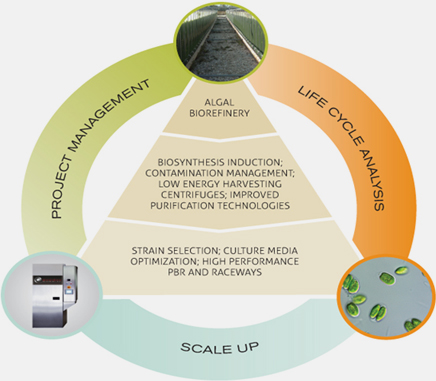|
|
|
| HOME > Research > Research Field |
| |
| Research Field |
| |
 |
| |
 Biomass convers Biomass convers |
| |
 |
| |
Recently, biofuels have attracted public attention as a source of renewable energy for replacing fossil fuel. Microalgae can take carbon dioxide from the air and grow faster than terrestrial plants. Using microalgae, high-concentration culture is possible in large quantities and even in extreme environments. Producing biodiesel from microalgal lipids is feasible since microalgae can accumulate lipid levels that are greater than 50% of their dry cell weight. Usually microalgae are photoautotrophic microbes, but in addition to using free sunlight as an energy source, microalgae can be cultivated using the nitrogen, phosphorus and hydrocarbons in wastewater.
After extraction of the lipids from cultivated microalgae, the extracted oils are usually converted to fatty acid methyl ether (FAME) using methanol and acid catalyst in a transesterification reaction. Such FAME can be used as a biodiesel after purification. Because microalgae are grown in liquid media, extraction is usually classified as wet extraction or dry extraction depending on whether or not the culture broth was dried before the lipid extraction step. Most of the current extraction processes are carried out after drying the wet microalgae to increase the amount of lipid extracted from the biomass. However, this drying process is responsible for up to 59 % of the total energy consumed during the biodiesel production.
To substantially reduce the impact of the energy consumed for the current drying process, improvement of the efficiency of wet extraction by adding other operations has recently emerged as a very important issue. Our current research focus is to combine the three processes of drying, extraction, and transesterification into one pot process (wet in-situ transesterification) to dramatically realize an efficient design of biodiesel production.
|
|
|
|
|
| |
|